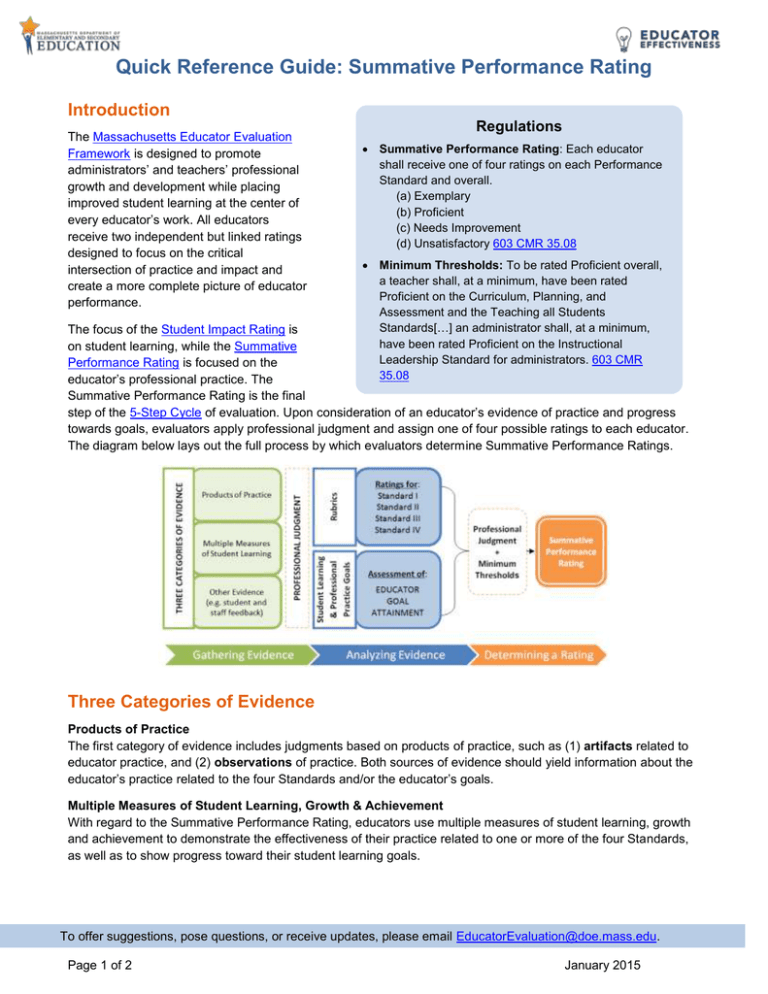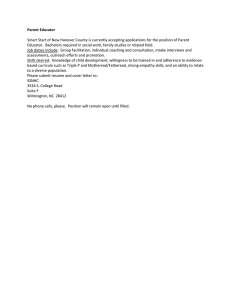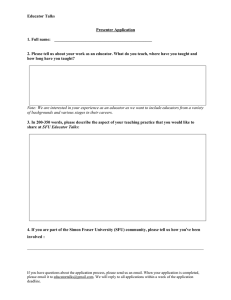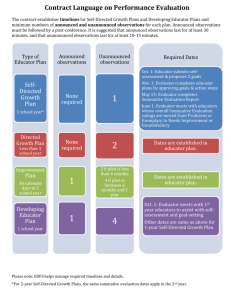QRG SummativeRating
advertisement

Quick Reference Guide: Summative Performance Rating Introduction The Massachusetts Educator Evaluation Framework is designed to promote administrators’ and teachers’ professional growth and development while placing improved student learning at the center of every educator’s work. All educators receive two independent but linked ratings designed to focus on the critical intersection of practice and impact and create a more complete picture of educator performance. Regulations Summative Performance Rating: Each educator shall receive one of four ratings on each Performance Standard and overall. (a) Exemplary (b) Proficient (c) Needs Improvement (d) Unsatisfactory 603 CMR 35.08 Minimum Thresholds: To be rated Proficient overall, a teacher shall, at a minimum, have been rated Proficient on the Curriculum, Planning, and Assessment and the Teaching all Students Standards[…] an administrator shall, at a minimum, have been rated Proficient on the Instructional Leadership Standard for administrators. 603 CMR 35.08 The focus of the Student Impact Rating is on student learning, while the Summative Performance Rating is focused on the educator’s professional practice. The Summative Performance Rating is the final step of the 5-Step Cycle of evaluation. Upon consideration of an educator’s evidence of practice and progress towards goals, evaluators apply professional judgment and assign one of four possible ratings to each educator. The diagram below lays out the full process by which evaluators determine Summative Performance Ratings. Three Categories of Evidence Products of Practice The first category of evidence includes judgments based on products of practice, such as (1) artifacts related to educator practice, and (2) observations of practice. Both sources of evidence should yield information about the educator’s practice related to the four Standards and/or the educator’s goals. Multiple Measures of Student Learning, Growth & Achievement With regard to the Summative Performance Rating, educators use multiple measures of student learning, growth and achievement to demonstrate the effectiveness of their practice related to one or more of the four Standards, as well as to show progress toward their student learning goals. To offer suggestions, pose questions, or receive updates, please email EducatorEvaluation@doe.mass.edu. Page 1 of 2 January 2015 Quick Reference Guide: Summative Performance Rating In contrast with the measures that inform the Student Impact Rating, which must be comparable across grade or subject level district-wide, measures that contribute to the Summative Performance may include classroom specific assessments that provide evidence of individual practice related to the Standards or goal attainment. Learn More about the Summative Performance Rating QRG: The Five-Step Cycle QRG: Performance Rubrics Other Evidence related to Standards of Practice (including Student or Performance Rating Guidance Staff Feedback) The third category of evidence must include feedback from students or staff. See the Quick Reference Guide on Staff & Student Feedback for more information. Other sources of information, such as evidence of fulfillment of professional responsibilities and evidence of family engagement, may also be considered. Educator Goal Attainment Every educator is required to have a minimum of two goals: a student learning goal and a professional practice goal. Overall goal attainment reflects progress across all goals. For example, if an educator exceeds his projected target on his student learning goal and makes significant progress on his professional practice goal, the evaluator may determine overall goal attainment as having met goal. See Part II of ESE’s Model System Guidance for more information about setting and evaluating educator goals. Summative Performance Rating Reporting ESE collects educator evaluation data on an annual basis. Districts submit the six data elements for each evaluated educator: a rating on each of the four Standards, the overall summative rating, and Professional Teacher Status. A seventh data element (Student Impact Rating) will be submitted once trends and patterns are established. For more information about reporting, read the Quick Reference Guide: Educator Evaluation Data Collection. Development of the Educator Plan An educator’s Summative Performance Rating determines their next Educator Plan based on the table below. The Self-Directed Growth Plan is developed by the educator and is either one or two years in length, depending on the Student Impact Rating; the Directed Growth Plan is developed by the educator and evaluator and is one year or less in duration; the Improvement Plan is developed by the evaluator and is 30 days to one year in duration; the Developing Educator Plan applies to educators without Professional Teacher Status (PTS), administrators in their first three years in a district, or educators in new assignments (at the discretion of their evaluators), and is a one-year plan developed by the educator and evaluator. The diagram below illustrates the relationship between a Summative Performance Rating and an Educator Plan, as well as the intersection of the Summative Performance Rating and Student Impact Rating. Performance Rating Exemplary Proficient 1-yr Self-Directed Growth Plan 2-yr Self-Directed Growth Plan Needs Improvement Directed Growth Plan Unsatisfactory Improvement Plan Low Moderate High Impact Rating To offer suggestions, pose questions, or receive updates, please email EducatorEvaluation@doe.mass.edu. Page 2 of 2 January 2015







